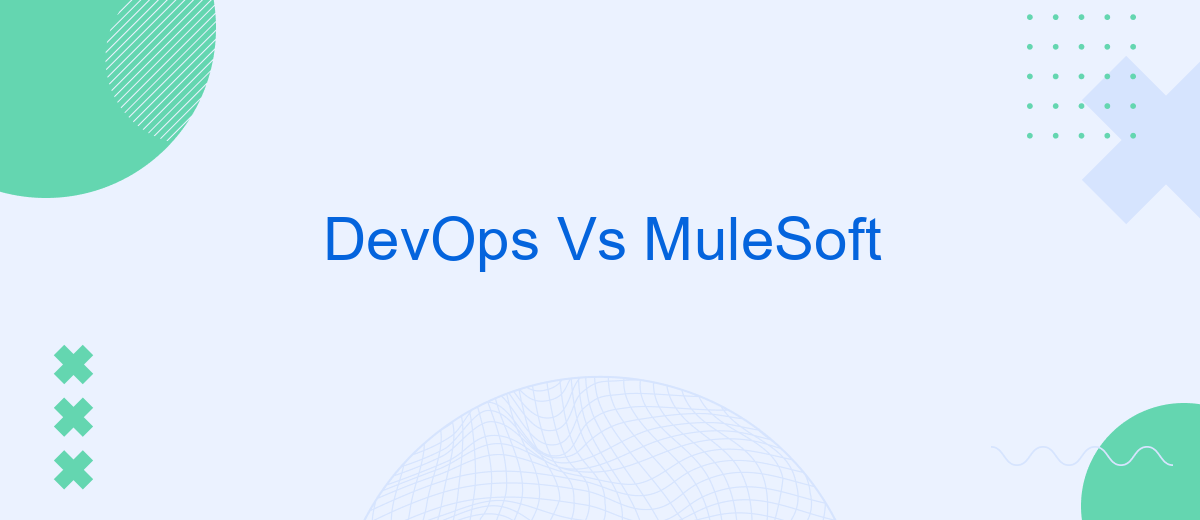In the rapidly evolving landscape of software development and IT operations, choosing the right tools and methodologies is crucial. DevOps and MuleSoft have emerged as pivotal solutions, each addressing unique aspects of the development lifecycle. This article delves into the core differences and synergies between DevOps and MuleSoft, helping you make informed decisions for your organization's needs.
Introduction
In the rapidly evolving landscape of IT and software development, DevOps and MuleSoft have emerged as pivotal technologies for streamlining processes and enhancing productivity. While DevOps focuses on the collaboration between development and operations teams to improve workflow and deliver software faster, MuleSoft specializes in API-led connectivity, enabling seamless integration of various applications and data sources. Understanding the differences and synergies between these two can significantly impact how organizations manage their IT infrastructure and integration requirements.
- DevOps: A culture and set of practices that bring development and operations teams together.
- MuleSoft: A platform that provides tools for building, deploying, and managing APIs and integrations.
- SaveMyLeads: A service that simplifies the integration process by automating data transfer between various platforms.
By leveraging the strengths of both DevOps and MuleSoft, organizations can achieve a more agile and responsive IT environment. DevOps enhances the efficiency of software delivery, while MuleSoft ensures that different systems can communicate effectively. Tools like SaveMyLeads further simplify these processes by automating integrations, allowing businesses to focus on innovation and growth rather than manual data handling.
Key Differences

DevOps and MuleSoft serve different purposes within the IT ecosystem. DevOps is a set of practices that combines software development (Dev) and IT operations (Ops) to shorten the systems development life cycle and provide continuous delivery with high software quality. It focuses on automation, continuous integration, and continuous deployment, aiming to improve collaboration between development and operations teams.
MuleSoft, on the other hand, is a platform for building application networks by connecting apps, data, and devices with APIs. It specializes in integration and API management, enabling businesses to seamlessly connect disparate systems. While DevOps emphasizes the overall software delivery process, MuleSoft focuses specifically on integration and connectivity. Tools like SaveMyLeads can complement MuleSoft by automating lead data integration across various platforms, further streamlining business processes. In summary, DevOps is about optimizing the development and deployment pipeline, whereas MuleSoft is about connecting and integrating different systems efficiently.
Advantages and Disadvantages

When comparing DevOps and MuleSoft, it's essential to understand their unique advantages and disadvantages. DevOps focuses on improving collaboration between development and operations teams to accelerate software delivery, while MuleSoft specializes in integrating various applications, data, and devices.
- DevOps enhances collaboration and communication, leading to faster delivery cycles and continuous integration/deployment (CI/CD).
- MuleSoft offers robust integration capabilities, allowing seamless connectivity between diverse systems and APIs.
- DevOps promotes automation, reducing human error and increasing efficiency in the software development lifecycle.
- MuleSoft's Anypoint Platform provides a unified environment for designing, building, and managing APIs and integrations.
- DevOps may require significant cultural and organizational changes, which can be challenging to implement.
- MuleSoft can be complex and may require specialized skills for effective implementation and maintenance.
While DevOps streamlines software development and deployment processes, MuleSoft excels in creating a cohesive integration ecosystem. Tools like SaveMyLeads can further enhance integration efforts by automating data flows between various services, reducing manual intervention and potential errors. Choosing between DevOps and MuleSoft depends on your organization's specific needs and goals.
Use Cases

DevOps and MuleSoft serve distinct yet complementary roles in modern IT environments. DevOps focuses on streamlining and automating the software development lifecycle, while MuleSoft specializes in integrating various applications, data, and devices. Understanding their individual use cases can help organizations leverage both for maximum efficiency and innovation.
DevOps is primarily utilized for automating deployment pipelines, continuous integration, and continuous delivery (CI/CD). This approach enhances collaboration between development and operations teams, ensuring faster and more reliable software releases. MuleSoft, on the other hand, excels in creating seamless integrations across disparate systems, enabling real-time data synchronization and improved business agility.
- Continuous Integration and Continuous Deployment (CI/CD) pipelines
- Automated infrastructure provisioning and management
- Real-time data integration and synchronization
- API management and orchestration
For instance, using a service like SaveMyLeads can simplify the integration of various marketing and sales platforms, automating lead management processes and ensuring that data flows smoothly between systems. Combining the strengths of DevOps and MuleSoft can thus lead to more efficient operations and enhanced business outcomes.
Conclusion
In conclusion, both DevOps and MuleSoft offer distinct advantages depending on the specific needs of an organization. DevOps focuses on streamlining the development and operations processes, enabling faster delivery and more reliable software releases. It emphasizes automation, continuous integration, and continuous delivery to enhance efficiency and reduce time-to-market. On the other hand, MuleSoft provides a robust platform for building application networks, facilitating seamless integration of various systems and services through APIs. It excels in enabling organizations to connect disparate applications, data, and devices, thereby driving digital transformation.
While DevOps and MuleSoft serve different purposes, they can complement each other in a comprehensive IT strategy. For instance, integrating MuleSoft's API-led connectivity with DevOps practices can result in a more agile and responsive IT environment. Tools like SaveMyLeads can further enhance this synergy by automating lead generation and data integration, ensuring that critical business information flows seamlessly across platforms. Ultimately, the choice between DevOps and MuleSoft—or a combination of both—depends on the unique requirements and goals of the organization.
- Automate the work with leads from the Facebook advertising account
- Empower with integrations and instant transfer of leads
- Don't spend money on developers or integrators
- Save time by automating routine tasks
FAQ
What is DevOps?
What is MuleSoft?
How do DevOps and MuleSoft complement each other?
Can I use automation tools to integrate MuleSoft with other services?
Which should I choose for my project: DevOps or MuleSoft?
You probably know that the speed of leads processing directly affects the conversion and customer loyalty. Do you want to receive real-time information about new orders from Facebook and Instagram in order to respond to them as quickly as possible? Use the SaveMyLeads online connector. Link your Facebook advertising account to the messenger so that employees receive notifications about new leads. Create an integration with the SMS service so that a welcome message is sent to each new customer. Adding leads to a CRM system, contacts to mailing lists, tasks to project management programs – all this and much more can be automated using SaveMyLeads. Set up integrations, get rid of routine operations and focus on the really important tasks.

